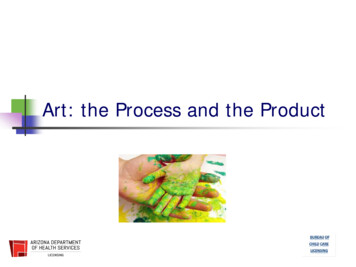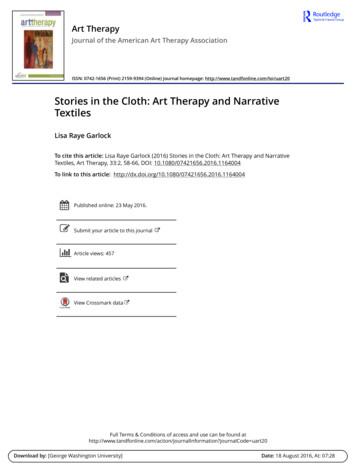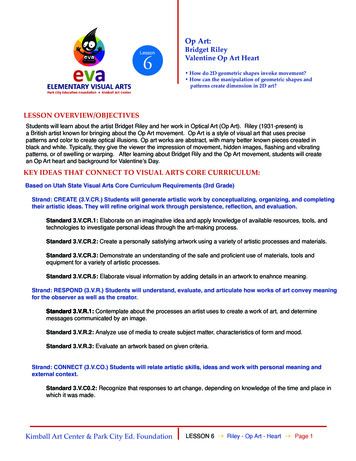
Transcription
Art: the Process and the Product
Art the Process and the Product Prepared and presented by the Bureauof Child Care Licensing, ADHS.
Introduction During this session, process and product artwill be discussed and explored.You will read the slides at your own pace. Itmay be a good idea to take some notes.At the end of the session you will have anassignment to complete in order to validateyour training certificate.
Overview During this training, you will explore and thinkabout offering art for infants through school agechildren in group care settings.Understanding the importance of art, and how tooffer art experiences to children, increases the staffmember’s skills when working with young children.During this training, you will explore the topics ofprocess art and product art.
Vocabulary Process artProduct artArtFree choiceTeacher directed choices
What is Art? Art is defined as the use of imagination orother ideas to help with the creation ofobjects that are pleasing to look at.Art can be a painting, a sculpture, a drawingor any other creative idea a child or adultcreates.Look around your classroom-make alist of all the materials you have inyour room that can be used for art.
Different Types of Art Typically, children are offered 2 types of artin the classroom: Process art or product art.Process art is an opportunity for children tocreate something based on their own ideas.Product art is an opportunity to createsomething that the teacher has thought of.Make a list of the process and theproduct art ideas you included in yourlesson plan this month.
Process Art Process art gives children a chance toexplore and manipulate materials in anyway that occurs to them. Most of thetime, you should offer process art tochildren.
Process Art Process art is an art idea that the teacher sets upwithout the end result in mind.An example would be: The teacher sets out smallbaskets of a variety of colored pieces of paper,found objects such as plastic milk lids, buttons,bright scraps of fabric trims, glue, scissors and an8” square of cardboard for each child. Children maychoose items and create a design on the cardboardsquare without instructions from the teacher.Make a list of 4 process art ideas you couldinclude in your next lesson plan.
Why Process Art? Children are given the opportunity to make choicesand experience what happens when they explore thematerials and observe the outcome.In addition to being fun, these concepts will beimportant later on in science and math class.As children have more experience making choicesand experiencing outcomes, they begin to be able topredict what will happen next.Predicting what comes next is an important part ofearly literacy.
More Processing . Children need lots of opportunities tofreely explore and make choices.This sets the stage for children to buildtheir self confidence and realize theyare in charge of their own learning.Creating process art can be a socialexperience-helping children learn abouttaking turns, sharing and co-operation.
Product Art Product art is an activity in which the teacheroffers materials with an end result in mind.An example of product art would bedecorating a heart shaped piece of paper witha lace doily and a poem to give to the parenton Valentine’s day.Think about some times when productart would be a good idea in yourclassroom. Write these ideas down.
Process or Product? Children need lots of opportunities to exploreand create, this supports early literacy andmath concepts.Most of the art experiences for youngchildren should be process art.On occasion, a product art experience isappropriate.Think about your classroom, and whenyou would offer process art and whenyou would offer product art.
Summary During this training session, process art andproduct art were discussed along with howand when to use each type of art withchildren.Explain any requirements for applying thistraining in your classroom with yourDirector.In order to validate your training certificateyou will need to complete the assignment onthe next slide.
Assignment Look at the art center in your room. Based onthe information contained in this session,create an age appropriate art center thatcan be available to the children in your roomthroughout the day.Add at least 2 process art ideas per week forthe next month.Discuss your art area with your Director.
More information Resources for art for young children can befound at your local library-check with thechildren’s librarian-they will help you findbooks and other resources for your agegroup.Be creative, think about using materials indifferent ways.Search online for process art ideas. Oneresource is Pinterest.
CERTIFICATE OF COMPLETIONThe individual listed above completed the moduleART: The Process and the Productand is receiving credit for 0.5 (1/2) hour of training. This individual is receiving an additional 1.5 hours of training forcompletion* of the training assignment. /DirectorDate*Director (or designee) must document a review of the assignment by placinginitials & date beside the check box.
Typically, children are offered 2 types of art in the classroom: Process art or product art. Process art is an opportunity for children to create something based on their own ideas. Product art is an opportunity to create something that the teacher has thought of. Make a list of the process and the product art ideas you included in your










